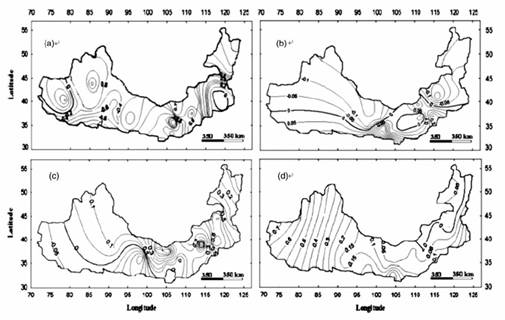In desert regions, the temporal–spatial patterns of precipitation and evapotranspiration have an especially strong influence on eco-hydrological processes. These processes control the spatial structures of the desert vegetation community and evolution of the plants.
Dr. Ligang XU, Xinjiang Institute of Ecology and Geography, Chinese of Academy of Sciences, investigated the spatial and temporal variations of precipitation in the desert region of China (DRC) from 1951 to 2005 using a rotated empirical orthogonal function (REOF), the precipitation concentration index (PCI) and the Mann–Kendall trend test method (M-K method). The results indicated that the spatial pattern of precipitation was primarily the local climate effect significant type, with the first three EOFs explaining a total of 55.3% of the variance, and the large-scale climate system effect type, which explained 9.8% of the variance. Prior to the 1970s, the East Asian summer monsoon was stronger, which resulted in abundant precipitation in the Inner Mongolia region. Conversely, the climate of the Xinjiang region was controlled by westerly circulation and had lower precipitation. However, this situation has been reversed since the 1980s. It is predicted that precipitation will decrease by 15–40 mm/a and 0–10 mm/a in the Inner Mongolia plateau and southern Xinjiang, respectively, whereas it will likely increase by 10–40 mm/a in northern Xinjiang. Additionally, 58–62% of the annual rainfall occurred during summer in the DRC, with precipitation increasing during spring and summer and decreasing in winter. The intra-annual precipitation is becoming uniform, but the inter-annual variability in precipitation has been increasing in the western portions of the DRC. The probability of precipitation during the study period increased by 30% and 22.2% in the extreme-arid zones and arid zones, respectively. Conversely, the probability of precipitation during the study period decreased by 18.5% and 37.5% in the semi-arid zones and semi-wet zones, respectively. It is predicted that the northwest portion of the DRC will become warmer and wetter, while the central part will become warmer and drier and the northeast part will be subjected to drought.
The result had been published on the Hydrological Processes, 2010, 24: 2947-2959. Doi: 10.1002/hyp.7708.

Figure 2 The pattern of the first four RLV for the annual average precipitation over the DRC
